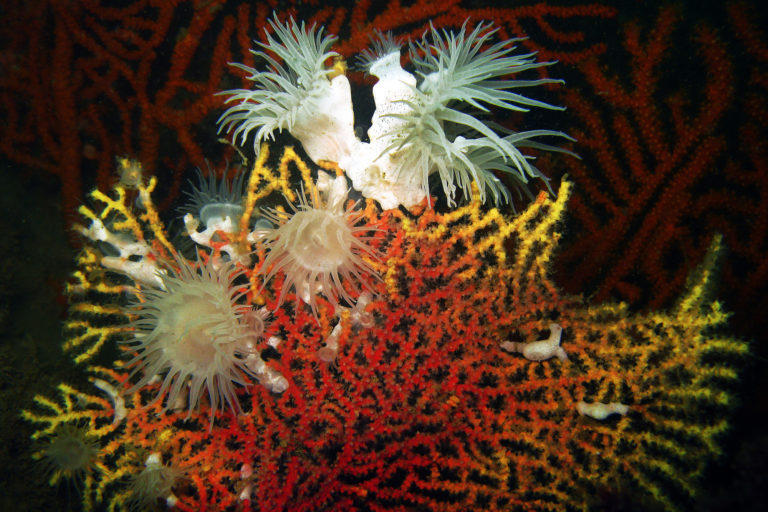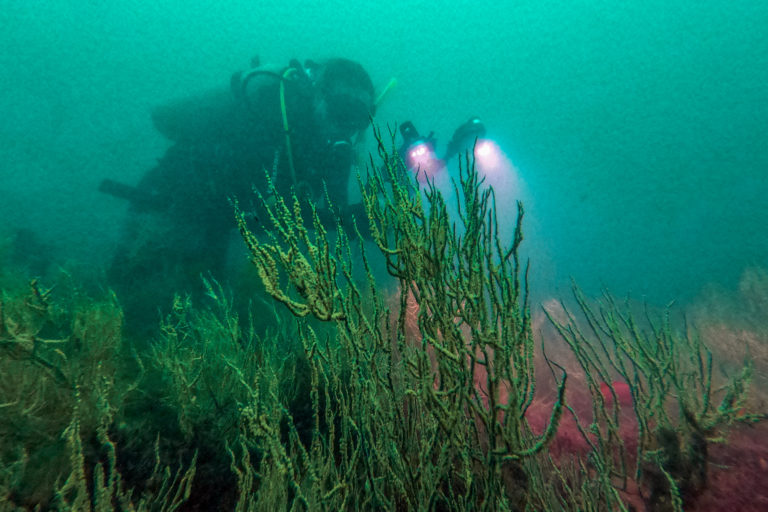- More than 1,000 species of fish, 1,018 mollusks and crustaceans and 215 echinoderms are known to live in Peruvian waters, and many species remain to be discovered and cataloged.
- Yet despite its rich biodiversity, Peru has no marine protected areas.
- Nearly 10 years ago, a movement began to urge the government to declare one in the tropical north of the country, home to more than 70% of Peru’s fish and invertebrate species.
- Mongabay spoke to Yuri Hooker, a marine scientist who has been pushing for the creation of the Grau Tropical Marine National Reserve.
When Yuri Hooker was young, he lived on the coast of Huanchaco in northern Peru. He grew up fascinated by the creatures and objects he found by the sea, and by what the fishermen brought in from their catches. At the age of 6 or 7, he watched a documentary by Jacques Cousteau for the first time. He was shocked to learn that it was possible to breathe underwater and gaze at everything down there. From that moment, he knew that one day he would become an underwater explorer.
Years later, he studied fisheries biology — marine biology wasn’t offered yet as a degree in Peru — and at the age of 18 he bought his first diving mask. He has continued to explore the sea ever since, becoming an icon as an expert on underwater biodiversity and one of the people calling for the creation of the much-awaited Grau Tropical Marine National Reserve.
The director of the biology laboratory at Universidad Peruana Cayetano Heredia (UPCH) in Lima, a producer and director of documentaries on the environment and conservation, and underwater photographer, Hooker has described at least 80 marine species.
Mongabay Latam spoke with him about his passion for the sea and about the extraordinary marine biodiversity that still awaits protection in Peru. The interview was translated from Spanish and lightly edited for clarity.

Mongabay Latam: How did your fascination with the sea begin?
Yuri Hooker: I believe that many of the things that define people’s lives happen in childhood — it did for me, at least. As a child, I was lucky enough to live on the coast of Huanchaco and, as with most future scientists, curiosity was the mother of my passion. Since then, right up to the present day, I have not stopped wondering about what lives below the surface and, from the moment I saw a muy muy (small sand crab) and what the fishermen were bringing in on their caballitos de totora [traditional reed raft], until today, when I find species unknown to science, the curiosity and desire to discover remain intact.
What do you think are the most amazing places in the Peruvian ocean? What have you seen there?
There are so many! It’s hard to describe. My favorite research site is the tropical north, north of Cabo Blanco, a place of maximum diversity in our sea and habitat to many endemic species that are new to science, and also a place with many large animals such as mantas, whale sharks [Rhincodon typus] and whales. As well as fan coral meadows, multicolored fish, large, threatened and increasingly rare fish such as the Pacific goliath grouper [Epinephelus quinquefasciatus], a species in real danger of extinction.

Another amazing area is between Sechura Bay and Foca Island, an area within the convergence zone of the tropical sea and the cold waters of the south. Many strange and unique species live here, where artisanal fisheries are also a cultural gem.
The Lobos de Afuera Islands are a place that should be protected as an intangible asset, as if it were our little Galápagos, a unique place in the world.
The great guano islands in the cold sea of the Peru Current are temples to marine productivity, the abundance of life within and outside the sea, a world full of valuable marine excrement. Paracas, part of this biological region, also has the greatest diversity of habitats on the entire coastline.
Finally, the coasts of Arequipa, which are very cold, deep and amazingly clear. Here the purity of the southernmost portion of the Peru Current’s ecosystem appears, with biological communities that we share with northern Chile.

What has been your most moving experience at sea?
Oh, that’s hard! I really can’t give an answer without writing a book. My first memories of life are the beach and the sea. My first memory of painfully learning to respect animals was after picking up a crab that wouldn’t let go of my little finger. The first time I put on a diving mask and put my head below the surface, floating in the wavy sea in Huanchaco; my first kiss, my first time … the first new species I discovered (which I later found out wasn’t new). The first time I dived using underwater breathing equipment in Paracas. My first dive in the tropical sea. My first species new to science. The first time I dived in a cave in the bowels of the Earth. The first time I saw a shark underwater and a whale. The first time I dived in Antarctica, in the Arctic, in the Mediterranean, in the cenotes of Mexico. So many first times! They are unforgettable. I suppose that one day a first time will come that will be the last and I’ll no longer be able to tell it.

How many species are known to exist in the Peruvian sea?
We still don’t know the number, as many marine species are still uncataloged. The best-known groups are fish (more than 1,000 species), mollusks, crustaceans (about 500), and echinoderms (215), while there are very few research studies on other organisms and their numbers are underestimated. Even in the best-studied groups, much remains to be discovered.
How many species new to science have you discovered in the Peruvian sea and which is your favorite?
Eighteen have been described and published. However, in UPCH’s Aquatic Zoology Collection I have at least 80 new species. Most are crustaceans, mollusks, echinoderms, corals and a couple of fish. The work is extremely slow as there is no way to finance the time it takes to make the descriptions and work is practically done in my free time. Additionally, I’ve made more than 100 new records of fish and invertebrates for Peru; that is, species that were known in other parts of the world, but not in Peru.

Which species do I like the most? Perhaps the red cold-water coral, Psammogorgia hookeri, because when I first saw it I immediately knew that it was a new species, since in the cold Peruvian sea we only have one species of fan coral. This species was very distinct, intensely red and came from waters below 30 meters [98 feet] deep. I collected it and started describing it, but it was my colleagues specializing in corals who finally described the species and dedicated it to me, which is why it bears my surname.
Why have no marine protected areas yet been designated in Peru?
There are no marine protected areas in Peru. We have two national reserves on the coast that include marine areas, but the protection is essentially of land, marine birds and mammals, and the management of some fishery resources, and covers practically nothing related to underwater biodiversity or endemic or threatened fish and invertebrate species. This has a lot to do with Peru’s vision of the sea since the ‘60s, whereby it intended to become a world fishing power in its territorial waters and believed that having one of the richest seas in the world made it inexhaustible and that exploiting it is a reason for pride. The current overexploitation shows us the opposite.

For nearly 10 years we’ve been trying to create a marine protected area in the tropical Peruvian north, a small area where more than 70% of all fish and marine invertebrate species live in Peru and where there is no protected area in the sea. Unfortunately, government after government has blocked this proposal in order to promote hydrocarbon exploitation.
What’s that place like underwater? What can you find down there?
The north of Peru is the southern distribution boundary of tropical waters in the Eastern Pacific, a huge ecosystem that runs from the Gulf of California in Mexico to Cabo Blanco in northern Peru. Here, 99% of fish are tropical, along with 100% of underwater invertebrates. About 80% of species are common throughout the eastern tropical Pacific, from Mexico to Peru, and some of the remaining 20% are species with more local distribution in the Pacific.

However, we have found a significant number of species that are only found in the north of Peru — species endemic to this lukewarm tropical sea that borders the cold waters of the Peru Current, which also transfers nutrients to the tropical area, making this a megadiverse and also very productive place. Here we have no coral reefs, but rocky reefs full of fan corals, sponges, anemones, ascidians and thousands of species that cover the rocks completely, without leaving a single centimeter of stone visible — everything is covered with life. This is also the place where Antarctic humpback whales [Megaptera novaeangliae] migrate every year and young Galápagos whale sharks come to feed and grow.
It’s a meeting place for hundreds of manta rays, the southernmost breeding site of sea turtles, with the largest (now overexploited) populations of Pacific seahorses [Hippocampus ingens]. It’s one of the few places you can find the Pacific goliath grouper, one of the most threatened species in the world and almost extinct in Peru in the absence of a marine protected area.

In addition, in the area there are communities of artisanal fishermen who fish by sail and with hooks, with age-old, highly selective techniques, who yearn for a protected area because they cannot compete with illegal trawling and purse-seine fishing which are destroying their fishing areas and livelihoods. In short, there are too many reasons to protect it.
What has enabled you to integrate photography and video into your work?
I believe that one of scientists’ most important roles is translating the knowledge they produce and making it accessible to people. Images are undoubtedly the best way to explain things and raise awareness, and filming is a way to get the viewer to accompany the scientist in the adventure of underwater research. Peru is changing rapidly and today people are struggling and fighting to protect the sea, especially the very young. When I started diving more than 30 years ago, there were only underwater hunters, but today there are hundreds, perhaps thousands of divers who don’t kill anything, who dive to admire the life, to take photos, to meet marine creatures and to be part of this new wave of people who will make the deep changes we so desperately need.

Banner image: Sea slug. Image by Yuri Hooker.
This article was first reported by Mongabay’s Latam team and published here on our Latam site on September 22, 2020.
The Link LonkJanuary 12, 2021 at 05:38PM
https://ift.tt/38zmS3N
Seeking a sanctuary for Peru's sea life: Q&A with Yuri Hooker - Mongabay.com
https://ift.tt/2CoSmg4
Sea
/cloudfront-us-east-2.images.arcpublishing.com/reuters/CZF6NULMVVMEXHOP7JK5BSPQUM.jpg)
No comments:
Post a Comment